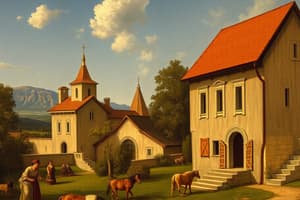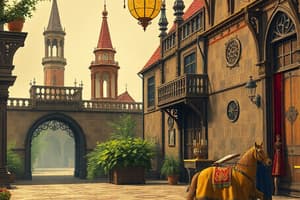Podcast
Questions and Answers
What was a primary reason for the structuring of society during Feudalism in England?
What was a primary reason for the structuring of society during Feudalism in England?
- Cultural exchange between different regions
- Land ownership and leasing hierarchy (correct)
- Influence of Renaissance art
- Focus on agricultural production
Which of the following factors contributed to the rise of vernacular languages during the Renaissance?
Which of the following factors contributed to the rise of vernacular languages during the Renaissance?
- Decline of the Church's influence
- Accessibility of education to the common people (correct)
- Increase in trade with non-Latin speaking nations
- The dominance of Latin in academic writing
Which architectural columns were used by Renaissance architects?
Which architectural columns were used by Renaissance architects?
- Doric, Ionic, and Corinthian (correct)
- Neoclassical and Baroque
- Tuscan and Composite (correct)
- Gothic and Romanesque
What significant impact did the Fall of Constantinople have during the Renaissance?
What significant impact did the Fall of Constantinople have during the Renaissance?
Which term best describes the cultural movement from the 15th to early 17th centuries in France?
Which term best describes the cultural movement from the 15th to early 17th centuries in France?
What was a key characteristic of classical antiquity's influence during the Renaissance?
What was a key characteristic of classical antiquity's influence during the Renaissance?
Which philosophical view emerged significantly during the Renaissance, emphasizing individual existence?
Which philosophical view emerged significantly during the Renaissance, emphasizing individual existence?
What was the dominant language for written texts in Europe during the Middle Ages?
What was the dominant language for written texts in Europe during the Middle Ages?
Flashcards
Renaissance
Renaissance
A period in European history, roughly from the 14th to the 17th centuries, marked by a renewed interest in classical art, literature, and philosophy, and significant advancements in various fields.
Humanism
Humanism
A philosophical movement during the Renaissance emphasizing human potential and achievements, focusing on earthly life rather than solely on religious matters.
Printing Press
Printing Press
A revolutionary invention by Johannes Gutenberg that enabled mass production of books, widespread knowledge dissemination, and cultural change.
Feudalism (England)
Feudalism (England)
Signup and view all the flashcards
Vernacular Languages
Vernacular Languages
Signup and view all the flashcards
Black Death
Black Death
Signup and view all the flashcards
Fall of Constantinople
Fall of Constantinople
Signup and view all the flashcards
Classical Antiquity
Classical Antiquity
Signup and view all the flashcards
Study Notes
General Information
- Renaissance marked a rebirth of Hellenistic and Roman Culture
- Increased interest in arts, humanities, and learning
- Bridged the gap between Middle Ages and modern civilization
- French for "rebirth"
- Humanism emphasized individual potential and ability of humans to shape their lives
Middle Ages
- Lasted from 500-1500 CE (or 1400)
- Experienced decline in population, economic vitality, and city size
- Known as the "Dark Ages" due to a lack of interest in arts and humanities
- The Crusades/Holy Wars occurred during this era
Black Death (Bubonic Plague)
- Killed approximately 30% of Europe's population
- Caused blackened tissue/gangrene
- Zoonotic disease spread by ticks or flea bites
Printing Press (Johannes Gutenberg)
- Developed in Mainz, Germany (1450)
- Allowed mass printing, enhancing knowledge and literacy
Medici Family
- Wealthy Florentine merchant family
- Supported Renaissance artists including Da Vinci, Michelangelo, Donatello, Botticelli
- Produced four popes: Leo X, Clement VII, Pius IV and Leo XI
- Supported the arts and humanities, contributing significantly to the Renaissance.
Fall of Constantinople
- Captured by the Ottoman Empire on May 29, 1453
- Marked the end of the Byzantine Empire and the beginning of the Ottoman Empire's expansion
- Renaming the city to Istanbul
- Severed trade routes and impacted European society
Renaissance Artists and Works
- William Shakespeare: Regarded as one of the greatest English writers (plays, sonnets, poems).
- Geoffrey Chaucer: "Father of English Literature" known for The Canterbury Tales
- Leonardo da Vinci: A true polymath (painter, engineer, anatomist, scientist) known for The Last Supper, Mona Lisa.
Albrecht Dürer
- German Renaissance artist (painter, printmaker)
- Famous for self-portraits
Donatello
- Italian Renaissance sculptor known for bronze sculptures
Michelangelo
- Italian Renaissance artist (sculptor, painter, architect, poet) known for the Sistine Chapel ceiling
Galileo Galilei
- Italian astronomer, physicist, and mathematician
- Revolutionized astronomy: observed celestial bodies with a telescope
- Supported the heliocentric model, challenging the prevailing geocentric view
Immanuel Kant
- Considered the most significant metaphysical and ethical philosopher
- Known for Deontology, emphasizing adherence to rules in moral judgments
- Proposed transcendental idealism, focusing on limitations of human knowledge
Karl Marx
- Advocated for a classless society
- Focused on class struggles and historical materialism
Modernism
- Embraces innovation, values individualism, and subjective experience
- Rejection of traditional norms
Pragmatism
- Focuses on practical consequences and real-world applications
- Values problem-solving approaches
Existentialism
- Emphasizes individual existence and freedom
- Individuals create their own meaning in life
Marxism
- Focuses on class struggle and historical materialism
- Advocates for collective ownership of resources
Idealism
- Believes reality is fundamentally mental or spiritual
- Ideas and consciousness are primary
Feudalism
- Dominant social and political system in Europe
- Focused on land ownership and obligations
Classical Antiquity in Renaissance
- Renaissance focused on revivalling classical ideals and thinkers
- Influenced art, culture, and philosophy
2nd Presentation: Bubonic Plague
- Pandemic ravaging Europe (1347-1351)
- Caused by Yersinia pestis bacteria
- Extreme death toll
Italian City-State Potarage
- Renaissance art often commissioned by wealthy patrons
- Artist contracts specified details
Vernacular Languages (3rd Presentation)
- The rise of vernacular languages in Europe (Middle Ages)
- Latin remained the dominant academic language, while vernacular languages gained influence during the Renaissance
- Printing press played a role in spreading use of vernacular languages
Why Vernacular Languages Rose
- nationalism fostered regional identities
- Decline of Latin's widespread use
Studying That Suits You
Use AI to generate personalized quizzes and flashcards to suit your learning preferences.




